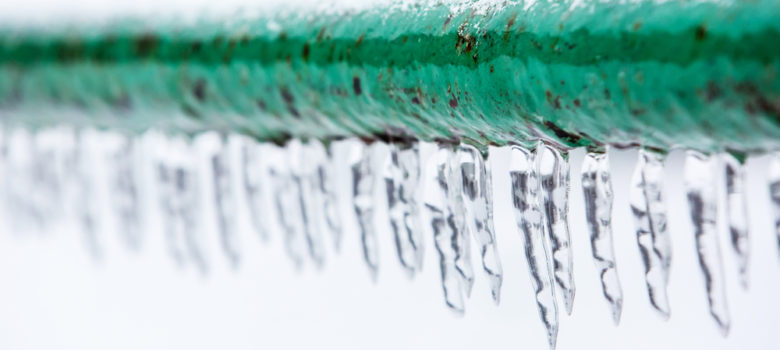
What happens when my pipes freeze?
Freezing pipes can cause chaos in your house. When the winter weather hits, thousands of us find ourselves waking up to cold radiators, no hot water, and a boiler making generally alarming sounds. A lot of modern boilers will give error messages to indicate where and what the problem is, unfortunately not all follow this rule and even those that do can be somewhat unreliable.
The majority of problems caused by the cold are down to condensing boilers, which are prime real estate for freezing to occur. As the name suggests, condenser boilers produce condensation as a byproduct of their system. This is routed out of your house through a small plastic pipe, but when the temperature drops this pipe is particularly susceptible to freezing. If this happens and the condenser pipe does in fact freeze then a blockage is formed and the boiler cannot operate, leaving you to face the cold with no heating or hot water. Less than ideal.

Cast iron pipes of any type are another big problem area to look out for when it comes to freezing concerns. As soon as the thermometers drop below 5c, thousands of pipes become vulnerable to the negative effects of low temperatures. In London and the South East alone there are around 12,000 miles of cast iron pipes, held together with an incalculable number of joints. As we all remember from our school days, cold shrinks and heat expands. The pipework is designed to survive a certain amount of this type of movement, however if the temperature drops dramatically then the system of pipes and joints is put under huge pressure as the entire system contracts. Joints that have become locked in place over time place tension on the pipes as they attempt to shrink while moving joints are forced to slide apart to compensate, creating gaps for water to escape. This is how small cracks turn in to large bursts.
How can I keep my pipes from freezing?
This is what my family have been calling me up all week to ask me. It’s understandable, the Association of British Insurers estimates the average cost of repair is between £6,500 and £7,500. Not exactly pocket change. As with most things though, the best and most cost effective form of treatment is prevention.
Any frequent readers of our blog will be able to tell you that we’re insulation crazy – whether it’s external wall insulation, loft insulation, or popping on an extra jumper for personal insulation, we love it and suggest you get on board. This goes double for pipes in the winter.

Before the weather hit, energy companies, boilers firms and water companies were urging everyone to ensure that their water tanks and pipes were insulated, covering all gaps at bends, valves and fittings. Pipe insulation is called lagging and can be bought from almost any DIY shop. If you know that cold weather is coming it’s always a good idea to check your boiler has been serviced in the last 12 months too.
Given that we’re now in the throes of some of the worst weather in years, it might be a little late for lagging your pipes. There are still things you can do in the way of prevention though:
- Pay special attention to any pipes in the coldest areas – garages, lofts, etc.
- In these subzero temperatures even the slowest dripping taps can cause a world of trouble. With all the advice and walkthroughs on YouTube and the internet at large, you don’t need to be a plumber to have a go at fixing them. Especially if you’re stuck at home due to snow anyway.
- With all the scares about the UK gas deficit and your own concerns about heating bills, it would be natural to want to turn your heating off when you’re not at home. But try keeping it on a low setting to protect your pipes if your weather turns when you’re out. A thermostat sitting at 9c will only trigger energy use if needed but could save you thousands on replacing a burst pipe.
What should I do if my pipes freeze?
- Turn your boiler off at the switch.
- If it’s a problem with your condensate pipe and you’ve got a ground floor boiler, then go outside and try to identify where the pipe exits the house. Generally this will be a small plastic pipe running from the back of your boiler, that exits into a gutter, gully or soil stack. If you can’t find it or it’s too high to reach then you’ll need to call a professional heating engineer. The sooner you can do this the better.
- Warm water or low heat hair dryers can be used to warm up the pipe. DO NOT attempt to thaw the frozen pipe with boiling water. My mum swears that the warm water method got her pipe clear with a single half-boiled kettle (melting the frozen blockage enough to release the bulk of the ice). I’m slightly skeptical of that claim; it can take a long time and a lot of tedious labour to get the pipe clear, but this is all dependent on the specific system and severity of the freeze. Power through, it’ll be worth it.
- When you’re satisfied that the pipe is clear then go back inside (hooray!) and try turning your boiler back on.
What should I do if my pipes burst?
- Try to locate and turn off the property’s internal stopcock or valve. In most homes this will be fitted under the kitchen sink and can be turned off by turning clockwise.
- Contact a plumber as soon as possible.
- When pipes begin to thaw turn on all your taps to drain the system and minimise the water damage from the burst pipe.
- Use thick towels to soak up as much of the leak as possible.
Think we missed something? Do you have a different opinion?
Comment below to get your voice heard…












There’s definitely a great deal to know about this issue.
I like all the points you have made.